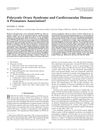Role of Oxidative Stress in Polycystic Ovary Syndrome
May 2010
in “
Current Women's Health Reviews
”

TLDR Oxidative stress is a key factor in the development of Polycystic Ovary Syndrome, and weight management can improve symptoms.
The document from May 1, 2010, reviews the role of oxidative stress in Polycystic Ovary Syndrome (PCOS), a complex condition characterized by symptoms such as hyperandrogenism, ovulatory disturbances, and metabolic issues like insulin resistance and obesity. It discusses the presence of oxidative stress in PCOS patients, evidenced by biomarkers like malondialdehyde (MDA), protein carbonyl, and reduced levels of antioxidants such as superoxide dismutase (SOD) and glutathione (GSH). The review also notes the importance of weight management in improving PCOS symptoms, as even a slight reduction in body weight can significantly improve ovulation, insulin sensitivity, and hormonal profiles. The document concludes that oxidative stress, along with insulin resistance and hyperandrogenemia, are key factors in the etiology of PCOS, and that further research is needed to understand the mechanisms and develop effective treatments. However, the document does not provide specific conclusions from a study or the number of people involved in the research, as it is a review of existing knowledge.












